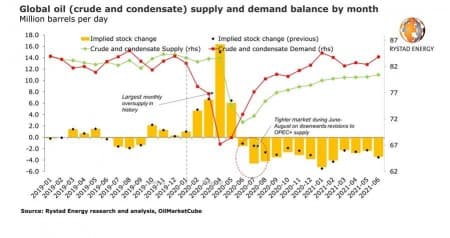The forced oil production shutdowns and the extension of the generous OPEC+ voluntary cuts into July will not only balance the Covid-19-hit global crude and condensate demand, but are deep enough to create a monthly deficit starting from June 2020 and continuing uninterrupted until at least the end of next year, a Rystad Energy analysis shows.
The oversupply, which sent WTI oil prices into the negative earlier this year, is a thing of the past as long as OPEC+ compliance stays strong and the oil demand recovery trajectory isn’t radically altered. The last surplus month appears to have been May, when crude and condensate production exceeded demand by about 6.1 million barrels per day (bpd).
June is now already set for a global production deficit of about 1.5 million bpd. The imbalance is forecast to reach 4.6 million bpd in July, 4.2 million bpd in August and, after being reduced a little during the remainder of 2020, peak at 5.2 million bpd in January 2021. Although the shortfall will ease after that, Rystad Energy estimates that monthly deficits will remain throughout next year.
“We believe OPEC+ is attempting to create a mini-bull-cycle by quickly tightening the prompt market, helping depressed prices and creating a supply environment that will facilitate a rapid relief of oil storages, as deficits will trigger large stock draws,“ says Rystad Energy’s Head of Oil Markets Bjørnar Tonhaugen.

Rystad Energy estimates that global crude and condensate production will stay below 80 million bpd for all the remaining months of 2020. Output will likely reach 71.4 million bpd in June and grow monthly to a high of 78.4 million bpd in December.
Demand, on the other hand, is set to reach 72.9 million bpd already in June 2020 and exceed 80 million bpd from September onwards, reaching an annual monthly high of 82.3 million bpd in December.
“However, if the oil price continues its steady ascension, this will spur reactivation of parts of the curtailed US oil production. Also, if frac crews end their holidays early, US volumes may be coming back more quickly than OPEC+ expects, bridging part of the deficit,“ adds Tonhaugen.
By Rystad Energy
More Top Reads From Oilprice.com:
- Will U.S. Shale Ever Return To Its Boom Days?
- Will Canadian Oil See Any Federal Help?
- OPEC+ Agrees On Extending Record Output Cuts



















Against this reality, Oil prices could be expected to range from $45-$50 a barrel during the second half of this year and touch $60 in early next year. Such a range will prevent US shale oil production coming back in force and will also retard expensive oil projects taking off.
My calculations suggest that global oil demand could reach 98.30 mbd in 2020 compared with 101.34 mbd in 2019, just 3 mbd below 2019 despite the horrendous destruction of global oil demand by COVID-19 pandemic.
And with a breakeven price ranging from $48-$68 a barrel, US shale oil producers need prices above $70 to start raising their production. Putting the hype of the US Energy Information Administration (EIA) aside, US shale oil drillers might manage to muster a production of 7-8 million barrels a day (mbd). This will propel US crude oil imports from 9 million barrels a day (mbd) in 2019 to an estimated 11-12 mbd in the next two years.
Dr Mamdouh G Salameh
International Oil Economist
Visiting Professor of Energy Economics at ESCP Europe Business School, London